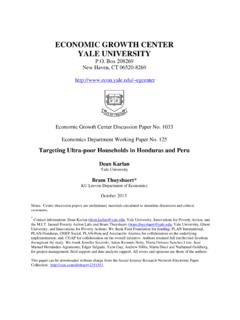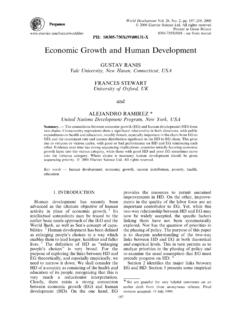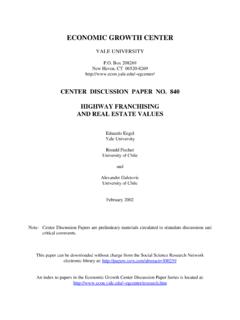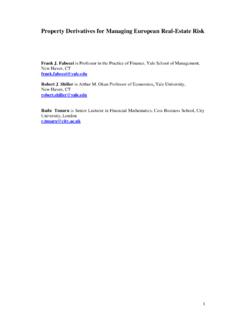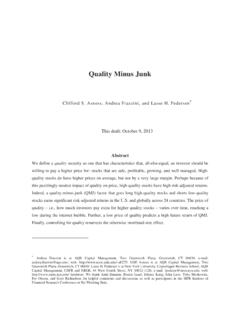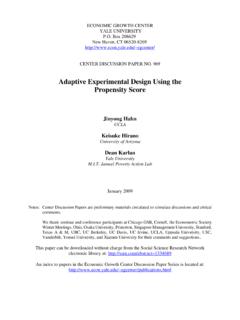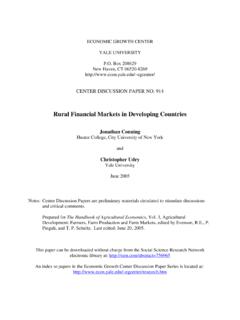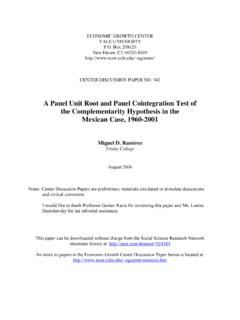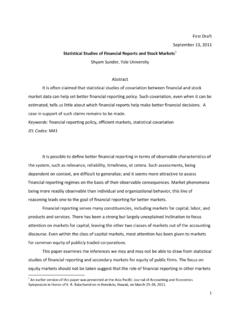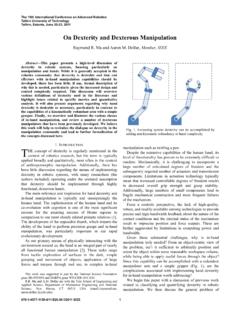Transcription of Finding Missing Markets (and a ... - Yale University
1 ECONOMIC GROWTH CENTER. yale University . Box 208629. New Haven, CT 06520-8269. ~egcenter/. CENTER DISCUSSION PAPER NO. 967. Finding Missing Markets (and a disturbing epilogue): Evidence from an Export Crop adoption and marketing Intervention in Kenya Nava Ashraf Harvard Business School Jameel Poverty Action Lab Xavier Gin . The World Bank Dean Karlan yale University Innovations for Poverty Action Jameel Poverty Action Lab December 2008. Notes: Center Discussion Papers are preliminary materials circulated to stimulate discussions and critical comments. We wish to thank Jonathan Campaigne, Vince Groh and Zack Lenawamuro for their work at DrumNet, and their patience and collaboration with this research.
2 We also would like to thank IDS. for the data collection efforts and IDRC, SAGA, and the World Bank for funding. Richard Akresh, Steve Boucher, Paul Dower, Steve Jaffee, Doug Miller and Julius Okello provided valuable comments. Sara Nadel from Innovations for Poverty Action, Guillem Roig and Paola de Baldomero provided excellent research assistance. Karlan thanks the National Science Foundation for support. All errors are our own. This paper can be downloaded without charge from the Social Science Research Network electronic library at: An index to papers in the Economic Growth Center Discussion Paper Series is located at: ~ Finding Missing Markets (and a disturbing epilogue): Evidence from an Export Crop adoption and marketing Intervention in Kenya Nava Ashraf Xavier Gin Dean Karlan Harvard Business School The World Bank yale University , Jameel Poverty Action Lab Innovations for Poverty Action, and Jameel Poverty Action Lab January 2008.
3 Abstract In much of the developing world, many farmers grow crops for local or personal consumption despite export options which appear to be more profitable. Thus many conjecture that one or several Markets are Missing . We report here on a randomized controlled trial conducted by DrumNet in Kenya that attempts to help farmers adopt and market export crops. DrumNet provides smallholder farmers with information about how to switch to export crops, makes in- kind loans for the purchase of the agricultural inputs, and provides marketing services by facilitating the transaction with exporters. The experimental evaluation design randomly assigns pre-existing farmer self-help groups to one of three groups: (1) a treatment group that receives all DrumNet services, (2) a treatment group that receives all DrumNet services except credit, or (3) a control group.
4 After one year, DrumNet services led to an increase in production of export oriented crops and lower marketing costs; this translated into household income gains for new adopters. However, one year after the study ended, the exporter refused to continue buying the cash crops from the farmers because the conditions of the farms did not satisfy European export requirements. DrumNet collapsed in this region as farmers were forced to sell to middlemen and defaulted on their loans. The risk of such events may explain, at least partly, why many seemingly more profitable export crops are not adopted. JEL Codes: O12, Q17, F13. Keywords: Field Experiment, Export Crop, Food Safety Standards 1.
5 Introduction Why do farmers continue to grow crops for local Markets when crops for export Markets are thought to be much more profitable? Several answers are possible: Missing information about the profitability of these crops, lack of access to the necessary capital to make the switch possible, lack of infrastructure necessary to bring the crops to export outlets, high risk of the export Markets ( , from hold-up problems selling to exporters), lack of human capital necessary to adopt successfully a new agricultural technology, and misperception by researchers and policymakers about the true profit opportunities and risk of crops grown for export Markets . We conduct a clustered randomized control trial with DrumNet, a project of Pride Africa, to evaluate whether a package of services can help farmers adopt, finance and market export crops, and thus make more income.
6 The experimental design includes two treatments, one with credit and one without, and a control group. The intervention is a package of services. Thus, the design does not permit isolating the reasons for the failure, with the exception of credit. In addition to evaluating the impact of these packages, we examine whether there are heterogeneous treatment effects on the basis of prior experience growing export crops. This experiment is motivated by a recent push in development to build sustainable interventions that help complete Missing Markets ( , the initiative launched jointly in 2006 by the Bill and Melinda Gates Foundation and the Rockefeller Foundation). Other similar interventions include the use of mobile phones to obtain real-time prices for fish in Markets along the shore by boat owners returning with their catches (Jensen, 2007) and 2.
7 An intervention in India to provide internet kiosks in small villages in order to better inform villagers of market opportunities (Upton and Fuller, 2005). Two approaches seem plausible for measuring impact of such interventions : one infers impact by examining the convergence of market prices (Jensen, 2007); a second compares the welfare, or change in welfare, of participants and non-participants. We employ the second approach. This design requires the assumption that there is no general equilibrium effects as a result of the intervention ( , increase of prices of non-export crops as a result of many farmers taking up export crops), and evidence we present supports this assumption.
8 To evaluate such a program, one should be concerned that entrepreneurial and motivated individuals (those with the unobservable spunk ) are most likely to participate; hence a randomized control trial seems necessary in order to measure the impact of such interventions convincingly. To the best of our knowledge, no such randomized controlled trial has been completed to date on an export crop adoption and marketing intervention. The literature on agricultural extension services, reviewed by Birkhaeuser et al. (1991) and Anderson and Feder (2003), and on technology adoption , reviewed by Feder et al. (1985) stress that both data quality and methodological issues are important qualifiers to the prevailing evidence in favor of high returns from extension or adoption .
9 They conclude that more evaluative work is needed to better assist We find positive but not overwhelming one-year impacts from DrumNet. DrumNet leads to more farmers growing export crops, increasing their production and 1. Foster and Rosenzweig (1995), Bandiera and Rasul (2004), Conley and Udry (2005) and Munshi (2004). also review the literature on agricultural technology adoption but focus on the role of social learning as a driver of adoption . This is the topic of our companion paper Ashraf, Gine and Karlan (2007). 3. lowering their marketing costs. While we do not find a statistically significant impact on income for the full sample, we do find a statistically and economically significant increase for first-time growers of export oriented crops.
10 The epilogue to this project is more dismal. One year after the evaluation ended, the export firm that had been buying the horticulture stopped because of lack of compliance with European export requirements (EurepGap). This led to the collapse of DrumNet as farmers were forced to undersell to middlemen, leaving sometimes a harvest of unsellable crops and thus defaulting on their loans. Afterwards it was reported to us anecdotally that the farmers returned to growing local crops. We discuss the implications (albeit without direct evidence): farmers may not be adopting export crops because of the risk of the export market. This paper proceeds as follows: Section 2 provides some background information regarding the Kenyan horticultural market and the DrumNet program.
